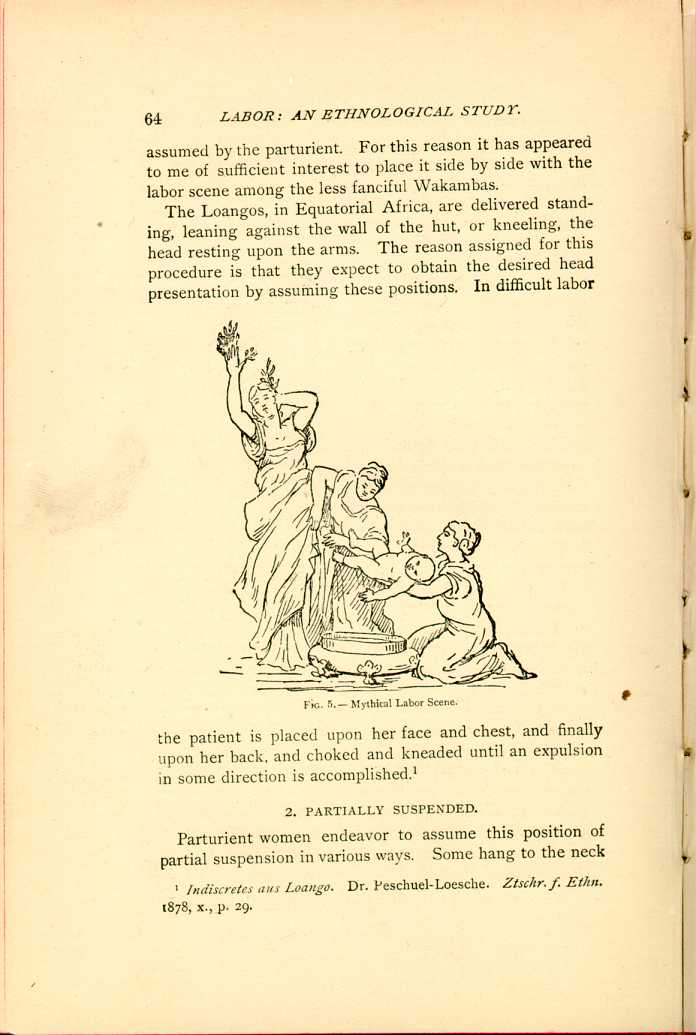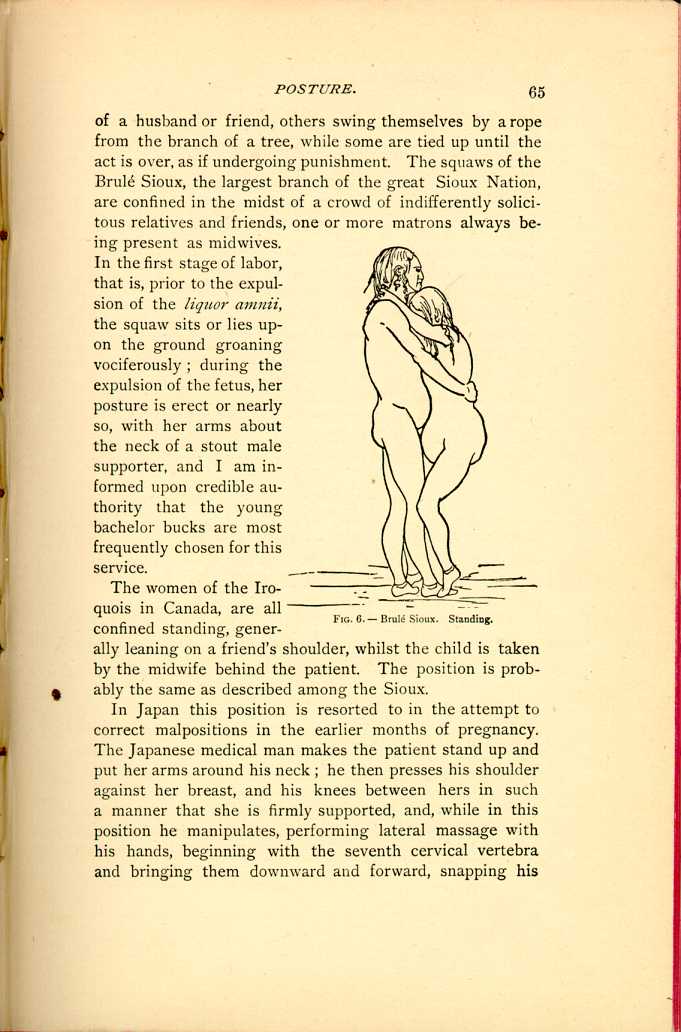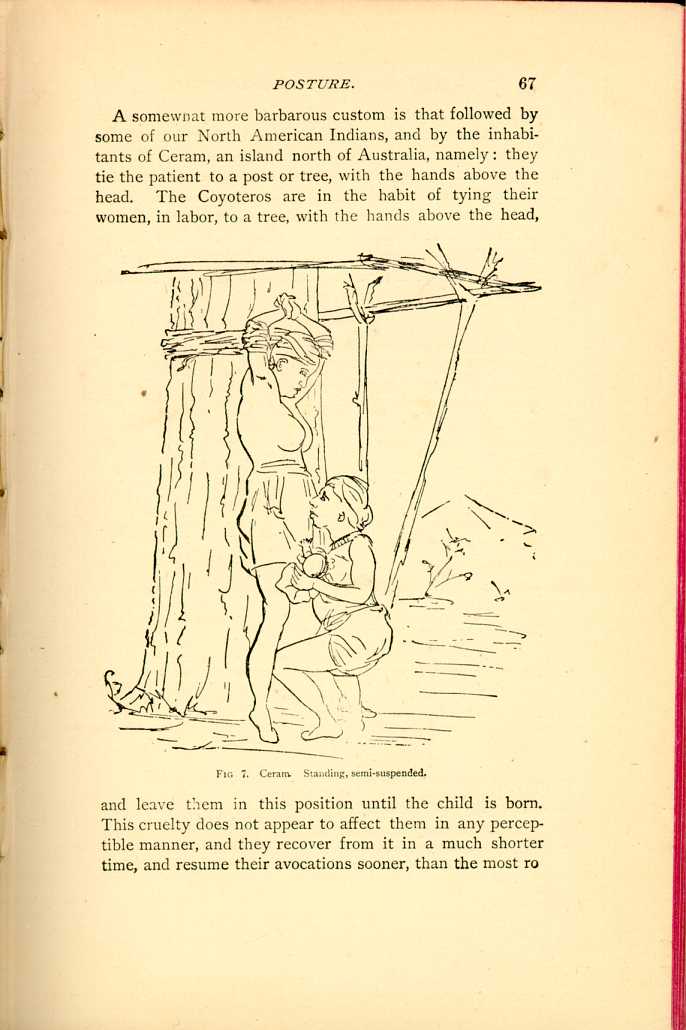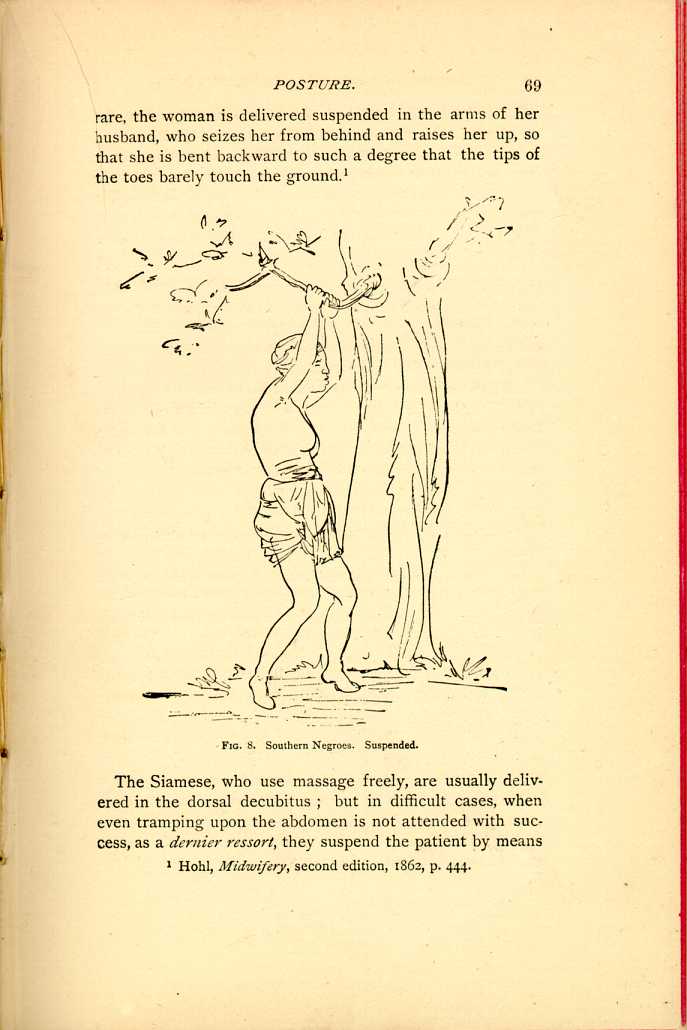| CHAPTER II.
POSTURE IN LABOR. Labor Among Primitive Peoples | ||
A. PERPENDICULAR OR UPRIGHT POSTURE.
Under this heading I shall discuss, individually, those positions in which the body is erect or almost so, and, in accordance with some slight variations, will distinguish: 1. The Standing, 2. The Partially Suspended, 3. The Entirely Suspended Positions.
1. STANDING.
We shall find this apparently uncomfortable position assumed even at the present day, and in our own country: Thus, Dr. H. F. Campbell, of Georgia, writes me that he has delivered a patient standing, clinging to the bed-post, who would rather dispense with his services than assume any other position. Among our Indians it is rarely observed, although I have been informed by a correspondent that the Sioux women are delivered standing erect; I think
The Hindoos, especially upon the eastern coast of India and in the vicinity of Madras, are delivered in an erect, standing posture, supported by an assistant under each shoulder—the midwife attending to her duties, being seated in front of the patient,[9] and whether rare or not at the present day the position is certainly traditionary, as bas-reliefs still exist upon the ancient Indian monuments which represent the act of delivery in this very same way.
In Central Africa, and near the Cape, among the Boers, the standing posture is not uncommon. Among the Negritos, upon the Philippine Islands, the parturient woman assumes the standing position, but apparently bent forward a little, as she supports the abdomen against a bamboo cane planted in the ground, thus apparently exercising some pressure upon the uterus.[10] Among the Wakambas, in Africa,
A similar position is shown in an old painting in the
Academy of Medicine in New York. (See Fig. 5.) The

FIG. 4.—Labor Scene among the Wakambas.
(Western portion of Central Africa.)
[Description: Woman giving birth while standing upright, supported by two
friends. Another woman kneels before her to receive the child. Black
and white illustration.]
The Loangos, in Equatorial Africa, are delivered standing,
leaning against the wall of the hut, or kneeling, the
head resting upon the arms. The reason assigned for this
procedure is that they expect to obtain the desired head
presentation by assuming these positions. In difficult labor

FIG. 5.—Mythical Labor Scene.
[Description: Two women assist in delivering baby from a robed woman. Black
and white illustration.]
2. PARTIALLY SUSPENDED.
Parturient women endeavor to assume this position of partial suspension in various ways. Some hang to the neck
The women of the Iroquois
in Canada, are all

FIG. 6.—Brulé Sioux. Standing.
[Description: Pregnant woman stands, supported by a man. She faces him with
her arms around his neck. Black and white illustration.]
In Japan this position is resorted to in the attempt to correct malpositions in the earlier months of pregnancy. The Japanese medical man makes the patient stand up and put her arms around his neck; he then presses his shoulder against her breast, and his knees between hers in such a manner that she is firmly supported, and, while in this position he manipulates, performing lateral massage with his hands, beginning with the seventh cervical vertebra and bringing them downward and forward, snapping his
The "New York Medical Record'' adds, that the accoucheurs are, in Japan, as a rule, advanced in age. If this custom is found in our own country it certainly comes to us from some of the inland countries of Europe. Thus, Spence, in his "System of Midwifery,''[14] says that the position which is very frequently practiced in the northern portion of Scotland, is that of hanging about the neck of a person as tall, or, if possible, taller than herself, who gently supports the patient's back, and with her knees fixes the knees of the woman in labor. In Italy it was Savonarola, who died in Padua in 1460, who taught that in difficult labors the parturient woman should either hang to the neck of a stout person or assume the knee-elbow position.[15]
The practice in some Mexican families[16] is to keep the woman in an upright position, with the knees and thighs slightly flexed, the feet wide apart, while she supports herself by two ropes suspended from above. He adds that massage is very freely resorted to, but no binder is at any time used.
We find precisely the same position in Africa among several native tribes. Thus, the Somali women assume an erect posture, partially suspended by a rope during the expulsion of the child, which is received by a family attendant or midwife.[17] So, also, we find that the women of Dar Fur, on the Nile, are delivered standing, with the legs separated,[18] holding on to a rope.
A somewhat more barbarous custom is that followed by
some of our North American Indians, and by the inhabitants
of Ceram, an island north of Australia, namely: they
tie the patient to a post or tree, with the hands above the
head. The Coyoteros are in the habit of tying their
women, in labor, to a tree, with the hands above the head,

FIG 7. Ceram. Standing, semi-suspended.
[Description: Woman gives birth leaning against a tree, her arms bound above
her. Another woman squats before her to assist delivery. Black and
white illustration.]
3. SUSPENDED.
Not unfrequently the negroes in our southern States still follow the customs brought from their African homes, or merely handed down by tradition; in their method of delivery they do not vary from that of the tribe from which they sprang. Occasionally the erect posture is taken, and a graphic description of such a labor has been given me, as witnessed in Louisiana. A negress gave birth to a child while hanging on to the limb of a tree. She would raise herself from the ground during the pains, whilst the assistant who was with her took charge of the child after it was born.[21]
In some portions of Finland, among the Esthen, as well as in some portions of Russia, the women are delivered in a similar manner while hanging to a cross-bar; they attempt, as it were, to shake out the child.[22]
We have the authority of Father Och that, in Brazil, the parturient woman occasionally has her arms tied to a tree while she is waited on by some old hags until the delivery is completed.[23]
In some portions of Germany, though the instances are

FIG. 8. Southern Negroes. Suspended.
[Description: Pregnant woman hangs by her hands from a tree branch. Black and white illustration.]The Siamese, who use massage freely, are usually delivered in the dorsal decubitus; but in difficult cases, when even tramping upon the abdomen is not attended with success, as a dernier ressort, they suspend the patient by means
| CHAPTER II.
POSTURE IN LABOR. Labor Among Primitive Peoples | ||